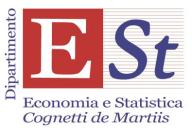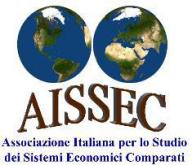By Sara Balestri and Marcello Signorelli[1]
Deforestation and forest degradation[2] are driven by multiple factors, including population growth (leading to a higher global demand for food and feed), demand for bioenergy products and trade of timber and timber-related commodities (FAO, 2020). An estimated 420 million ha of forest has been lost worldwide through deforestation since 1990. Although the annual global rate of forest loss has decreased substantially (FAO, 2023), large heterogeneous patterns can be identified at the regional level: while Asian countries have performed remarkably well with a net positive change in forest cover over the past three decades, South America and Sub-Saharan Africa have lagged behind. However, different trends can also be traced here: while in Latin America the rate of deforestation, although still high in absolute terms, is slowing down over time, in Africa the net loss of forests is increasing.
Within this scenario, the Sustainable Development Goals Framework (namely, the SDG 15 – Life on Land) includes forests among the terrestrial ecosystems whose conservation, restoration and sustainable use have to be ensured by 2020 (target 15.1) and commits towards promoting sustainable management of all types of forests, halting deforestation, restoring degraded forests and substantially increasing afforestation and reforestation globally by 2020 (Target 15.2). Notwithstanding, global forest area continues to decline, primarily due to agricultural expansion, despite notable progress in sustainable forest management and such targets are unlikely to be met even extending the timeframe to 2030. Urgent action is imperative, especially in the Global South where the enforcement of sustainable forest management systems is more problematic.
Beyond the obstacles that countries face in implementing effective sustainable forest management, the actions of other countries - as they can generate positive or negative cross-border effects - can impact the ability of an economy to achieve the SDGs. According to Sachs et al. (2023), we can recognize different types of spillovers, namely environmental and social impacts embodied into trade; those related to economic and financial flows; and those related to multilateralism, peacekeeping and security effects. We argue that negative spillovers, as they can delay or even prevent the achievement of the SDGs by reducing the impact of domestic investments, especially in resource limited contexts (e.g. LMICs and Emerging Economies) should be monitored with caution. In an increasingly interconnected world characterized by long, complex and often cross-border supply chains, in fact, it becomes essential to measure the unintended externalities generated by the countries’ consumption levels in other economies.
As far as regards deforestation, the European Union is increasingly aware of its role as a major economy and consumer of these commodities linked to deforestation and forest degradation abroad. For example, the recent Regulation (EU) 2023/1115 on deforestation-free products requires that the products EU citizens consume do not contribute to deforestation or forest degradation worldwide, thus avoiding the generation of environmental spillovers.
In this work, we focus on environmental spillovers to assess the role of global trade to hinder SDGs’ achievement in Emerging Economies. Despite a growing interest on socio-economic spillovers – such as child labour (Gómez-Paredes et al., 2016) and occupational health (Malik, Lafortune, Carter, et al., 2021; Malik, Lafortune, Mora, et al., 2024) – the environmental dimension remains overlooked. To contribute filling this gap and provide useful insights with respect to deforestation-related issues, we undertake a comprehensive assessment of the imported deforestation[3] embodied in the goods that are ultimately consumed by European countries, particularly focusing on timber and timber-related commodities. The research aim is twofold: i) providing a systematic exploration of the EU-consumption impact and ii) identifying entry points to improve policy-related tools and facilitate coherence between national and international policies. This is a work-in-progress research still at the initial stage of analysis; however, the preliminary descriptive results already provide some interesting insights.
The EU-27 imports are estimated to have contributed to an average imported deforestation rate of 23.36 m²/capita in 2022, roughly corresponding to a surface of 8,313 km² in origin countries. After a remarkable increase of the imported deforestation rate after 2015, today the EU-27 is on its path to reducing such spillover reporting an overall variation of - 2.84% over the period 2016-2021. However, heterogeneous trends are reported across European countries: while Italy and Germany – leading importing countries – drive the overall decreasing trend, northern European countries are increasing their spillovers, instead. According to the Global Commons Stewardship Index 2024, among the production sectors in origin countries where the analysed negative impact occurs most (i.e., local deforestation driven by the production of trade commodities), agricultural production (such as fruit and nut cultivation, legume crops and oilseeds) and, above all, forestry and logging stand out. This suggests that land use changes towards agricultural development and forestry often fail to meet sustainable forest management schemes[4], which, to varying degrees, are increasingly present in both advanced and emerging economies. A relevant share of the timber produced – especially in the Global South – is destined for export and the European market results as one of the major trade destinations. For this reason, we decided to focus on imports of timber and timber-related commodities as they are linked to a prominent source of imported deforestation spillover, although this production sector does not entail the whole dimension of the spillover under scrutiny.
We operationalize this choice by referring to the category HS44 (2 digits) - i.e. Wood and articles of wood – from COMTRADE database for the period 2016-2022 to roughly measure the trade flow of interest. The EU-27 gross imports in 2022 correspond to 64,073.33 (million USD), with the main importing countries being Italy (12%) and Germany (19%). Once we examine the non-EU countries of origin, we note that up to 70% are emerging economies (such as China, Brazil, Indonesia and the Russian Federation) denoting a clear trade pattern and making our initial consideration about the opportunity of analysing imported deforestation spillovers highly relevant in a development perspective. In addition to that, three exporting countries are implementing or negotiating a Voluntary Partnership Agreement (VPA)[5] with the EU under the Forest Law Enforcement, Governance and Trade (FLEGT) initiative.
From this introductory scenario we derive some preliminary reflections and those questions that will guide our research work.
First, despite an increasing number of countries adopting forest regulation measures, forestry and logging remain the primary production sector connected with environmental spillovers (that is, imported deforestation), suggesting the existence of poor national governance systems which call for substantial enhancement. So, considering timber and timber-related commodities trade, where are the greatest impacts of European consumption recorded? Which regulations are adopted in these countries? To answer to these questions, we will reconstruct European imports to estimate imported deforestation spillovers by means of Global Resource Input Output Assessment (GLORIA) – multi-regional input-output (MRIO) data and then scrutinize the forest regulations adopted in origin countries.
Second, the world currently does not have a global governance mechanism to coherently address spillover impacts associated with unsustainable global supply chains. With the EU being one of the largest importing markets, can EU forest policy achieve effective results in reducing spillover impacts on forests globally? Are the countries with Voluntary Partnership Agreements characterized by lower levels of (European) imported deforestation? We will explore possible heterogeneity of imported deforestation according to the existence of policy regulations and we will use current data as baseline provide some scenario analysis on the effect generated by the implementation of the Regulation (EU) 2023/1115 on deforestation-free products.
[1] Sara Balestri - senior researcher, Marcello Signorelli - full professor, Department of Economics, University of Perugia.
[2] We rely on the definitions of ‘deforestation’ (that is, the conversion of forest to agricultural use, whether human-induced or not) and ‘forest degradation’ (that is, the structural changes to forest cover, taking the form of the conversion of: (a) primary forests or naturally regenerating forests into plantation forests or into other wooded land; or (b) primary forests into planted forests) as provide by the European Commission.
[3] Imported deforestation refers to deforestation occurring abroad caused by the production of those goods imported for final consumption locally (Sachs et al., 2023). It is measured in m²/per capita.
[4] According to the Helsinki Resolution (1993), sustainable forest management is a dynamic and evolving concept which implies that “the stewardship and use of forests and forest lands in a way, and at a rate, that maintains their biodiversity, productivity, regeneration capacity, vitality and their potential to fulfil, now and in the future, relevant ecological, economic and social functions, at local, national, and global levels, and that does not cause damage to other ecosystems”.
[5] A Voluntary Partnership Agreement (VPA) is a legally binding trade agreement between the EU and a timber-exporting country outside the EU. A VPA aims to ensure that all timber and timber products destined for the EU market from a partner country comply with the relevant laws of that country.









